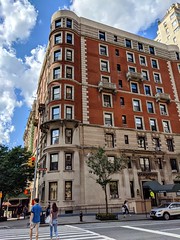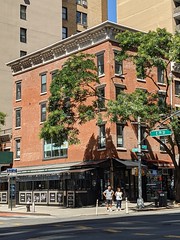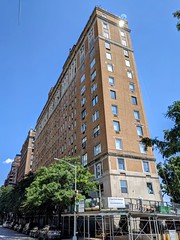South:
Fifth Avenue to Madison, from 78th to 79th, is known as the Cook Block, bought in 1883 by railroad tycoon Henry H. Cook, who insisted that only opulent single-family homes be built on his property.

2 (corner): A five-story townhouse built in 1899
to a CPH Gilbert design, decorated with images of sea life. The first owner was coal tar magnate Isaac Fletcher; after he died in 1917,
it was bought by Harry Sinclair of Sinclair Oil, who spent a year in prison in connection with the Teapot Dome scandal. In 1930, the house was bought by Augustus van Horne Stuyvesant, the last patrilineal descendant of Peter Stuyvesant. Two years after his death in 1953, it became the headquarters of the Ukrainian Institute of America. It appears as the Valmont mansion in Cruel Intentions.

4: Designed in 1899 in an extravagent Beaux Arts style by CPH Gilbert for business executive James E. Nichols. Nichols' widow died here in 1915, accidentally killed in a robbery orchestrated by a former butler. It was subsequently bought by banker Joseph Wright Harriman, who later went to prison for bank fraud. In 1938, Ogden Phipps became the owner and dulled down the architecture. From 1946 until 1973 it was the French Mission to the UN.

6: This striking
red and white facade was designed in 1900 by Barney & Chapman for dilettente Fred Gephard, best remembered for his open affair with very married actor Lillie Langtry.
8: This granite-faced mansion was built in 1910 for
Henry Schniewind, founder of the Susquehanna Silk Mills (not to be confused with the
Susquehanna Hat Company).
 It was bought in 1970 by the Greek Orthodox Archdiocese, which still uses it as offices.
It was bought in 1970 by the Greek Orthodox Archdiocese, which still uses it as offices.
10: Built in 1902 for Civil War naval
Capt. John Sanford Barnes. Since 1942 it's served as a residence for the
Archbishop of the Greek Orthodox Church of North and South America.
12: This and No. 14 to its east were designed as a pair by Arthur Little for real estate investor Charles W. Ogden and his sister Mary F. Ogden.
 This one was later the
School of Practical Philosophy, noted for its happiness-promising subway ads. It was connected to London's School of Economic Science, which some have called a
cult. The building is now Guidepost Montessori.
This one was later the
School of Practical Philosophy, noted for its happiness-promising subway ads. It was connected to London's School of Economic Science, which some have called a
cult. The building is now Guidepost Montessori.
14: Iraq's mission to the UN. From 1990–2003, this was the only Iraqi diplomatic outpost in the US. The New York Post
claimed that Saddam Hussein kept a secret torture chamber for Iraqi expatriates in the basement here.
16: A
neo-Georgian mansion designed by Warren & Wetmore. It was built from 1902-04 for Sidney Dillon, an insurance executive. He died here from appendicitis in 1905, just over a year after moving in. The building was converted to doctors' offices in 1956, losing much of its architectural detail in the process; the most famous practitioner here was Steven Levenkron, a psychotherapist who specialized in eating disorders, with Karen Carpenter among his patients. Since 1979 a series of art galleries have been on the ground floor—most recently Emma Scully Gallery, which
describes this building as a "19th century townhouse."
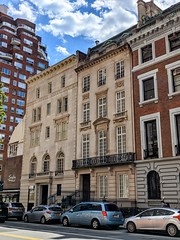
18: Built in 1909 for banker J. Woodward Haven, this townhouse is faithfully based (by architect Ogden Codman) on an 18th century house in Bordeaux. In 1926-27 it was home to William Vincent Astor, who was called the "richest boy in the world" after his father died on the Titanic. In 1937 it was bought by four-time national racquets champion Richard Mortimer, who in 1947 died of a heart attack here at the age of 56.
Fine arts dealers Duveen Brothers, which sold Leonardos, Raphaels, Vermeers and Rembrandts to Fricks, Rockefellers, Morgans and Whitneys, purchased the building in 1951. When the firm liquidated in 1964, its owner traded this building to Acquavella Galleries in exchange for two paintings by Renoir and Fantin-Latour. That gallery has been here since 1967, representing artists like Picasso, Renoir, Monet, Degas and Cezanne.
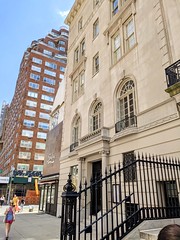
20: An Italianate building from 1913, first occupied by banker
Dudley Olcott. After Mrs. Olcott left him for a Russian prince, the building was sold in 1933 to stock broker Chester Dale, who used it to display his extensive collection of 20th century masterpieces (Picasso, Renoir, Degas, Monet, Matisse...), which ended up in the National Gallery. (Dale and his wife rented rooms at the Plaza to live in.) The building is now the
Skarstedt Gallery, which specializes in more recent artists like de Kooning, Warhol and David Salle.

Corner (1022 Madison): The five-story limestone and brick building built on this corner in 1911 is the only one of the block's grand houses not to survive. It was owned during almost all its existence by paint maker Edward H. Raynolds, who is remembered for allowing his second wife to torment his two sons by his first marriage. (See Daytonian.) It was torn down and replaced in 1949 with an "architectural aberration"—which since 1995 been the original flagship of the
Serafina pizza chain.
| 







